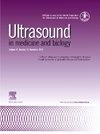Diagnosis of Salivary Gland Tumors Using Ultrasound Radiomics
IF 2.4
3区 医学
Q2 ACOUSTICS
引用次数: 0
Abstract
Objective
The current diagnosis of salivary gland tumors (SGTs) is dependent on subjective ultrasound features. Here we aimed to develop an objective method using ultrasound radiomics.
Methods
We collected 248 benign and 46 malignant images and divided them into training (80%) and testing (20%) groups, with 105 radiomic features extracted from each image. Data re-sampling, feature selection and classification were conducted. The diagnostic accuracy of different combinations was evaluated.
Results
After data re-sampling using the Synthetic Minority Over Sampling Technique (SMOTE) and feature selection with LASSO+ANOVA, 10 radiomic features were selected. Using the Random Forest classifier, the testing set achieved an area under the receiver operating characteristic curve of 0.85, accuracy of 90%, sensitivity of 78% and specificity of 92% for diagnosing SGTs. It maintained an accuracy of 85% in a separate internal validation set.
Conclusion
This study offers significant insights into the use of radiomics for the diagnosis of SGTs. When selected properly and paired with a suitable classification model, radiomics can be used to differentiate between benign and malignant SGTs.
超声放射组学诊断唾液腺肿瘤。
目的:目前唾液腺肿瘤(sgt)的诊断依赖于主观超声特征。在这里,我们的目的是发展一种客观的方法,利用超声放射组学。方法:收集248张良性图像和46张恶性图像,将其分为训练组(80%)和测试组(20%),每张图像提取105个放射学特征。进行数据重采样、特征选择和分类。评价不同组合的诊断准确性。结果:采用合成少数派过采样技术(SMOTE)和LASSO+ANOVA进行特征选择后,选择了10个放射学特征。使用随机森林分类器,测试集诊断sgt的受试者工作特征曲线下面积为0.85,准确率为90%,灵敏度为78%,特异性为92%。它在单独的内部验证集中保持85%的准确性。结论:本研究为使用放射组学诊断sgt提供了重要的见解。当选择正确并与合适的分类模型配对时,放射组学可用于区分良性和恶性sgt。
本文章由计算机程序翻译,如有差异,请以英文原文为准。
求助全文
约1分钟内获得全文
求助全文
来源期刊
CiteScore
6.20
自引率
6.90%
发文量
325
审稿时长
70 days
期刊介绍:
Ultrasound in Medicine and Biology is the official journal of the World Federation for Ultrasound in Medicine and Biology. The journal publishes original contributions that demonstrate a novel application of an existing ultrasound technology in clinical diagnostic, interventional and therapeutic applications, new and improved clinical techniques, the physics, engineering and technology of ultrasound in medicine and biology, and the interactions between ultrasound and biological systems, including bioeffects. Papers that simply utilize standard diagnostic ultrasound as a measuring tool will be considered out of scope. Extended critical reviews of subjects of contemporary interest in the field are also published, in addition to occasional editorial articles, clinical and technical notes, book reviews, letters to the editor and a calendar of forthcoming meetings. It is the aim of the journal fully to meet the information and publication requirements of the clinicians, scientists, engineers and other professionals who constitute the biomedical ultrasonic community.

 求助内容:
求助内容: 应助结果提醒方式:
应助结果提醒方式:


